2015 FIAT GRANDE PUNTO ACTUAL headlights
[x] Cancel search: headlightsPage 134 of 216
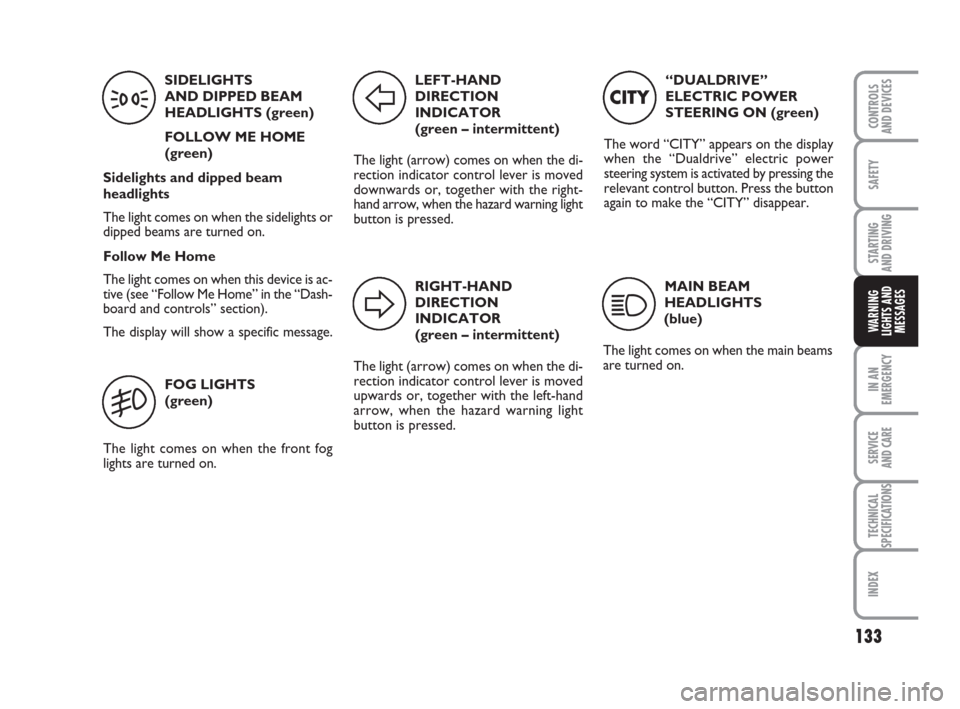
133
SAFETY
STARTING
AND DRIVING
IN AN
EMERGENCY
SERVICE
AND CARE
TECHNICAL
SPECIFICATIONS
INDEX
CONTROLS
AND DEVICES
WARNING
LIGHTS AND
MESSAGES
“DUALDRIVE”
ELECTRIC POWER
STEERING ON (green)
The word “CITY” appears on the display
when the “Dualdrive” electric power
steering system is activated by pressing the
relevant control button. Press the button
again to make the “CITY” disappear.
CITY
MAIN BEAM
HEADLIGHTS
(blue)
The light comes on when the main beams
are turned on.
1
FOG LIGHTS
(green)
The light comes on when the front fog
lights are turned on.
5
LEFT-HAND
DIRECTION
INDICATOR
(green – intermittent)
The light (arrow) comes on when the di-
rection indicator control lever is moved
downwards or, together with the right-
hand arrow, when the hazard warning light
button is pressed.
F
RIGHT-HAND
DIRECTION
INDICATOR
(green – intermittent)
The light (arrow) comes on when the di-
rection indicator control lever is moved
upwards or, together with the left-hand
arrow, when the hazard warning light
button is pressed.
D
SIDELIGHTS
AND DIPPED BEAM
HEADLIGHTS (green)
FOLLOW ME HOME
(green)
Sidelights and dipped beam
headlights
The light comes on when the sidelights or
dipped beams are turned on.
Follow Me Home
The light comes on when this device is ac-
tive (see “Follow Me Home” in the “Dash-
board and controls” section).
The display will show a specific message.
3
123-134 ACTUAL 1ed EN 31-08-2010 9:24 Pagina 133
Page 148 of 216
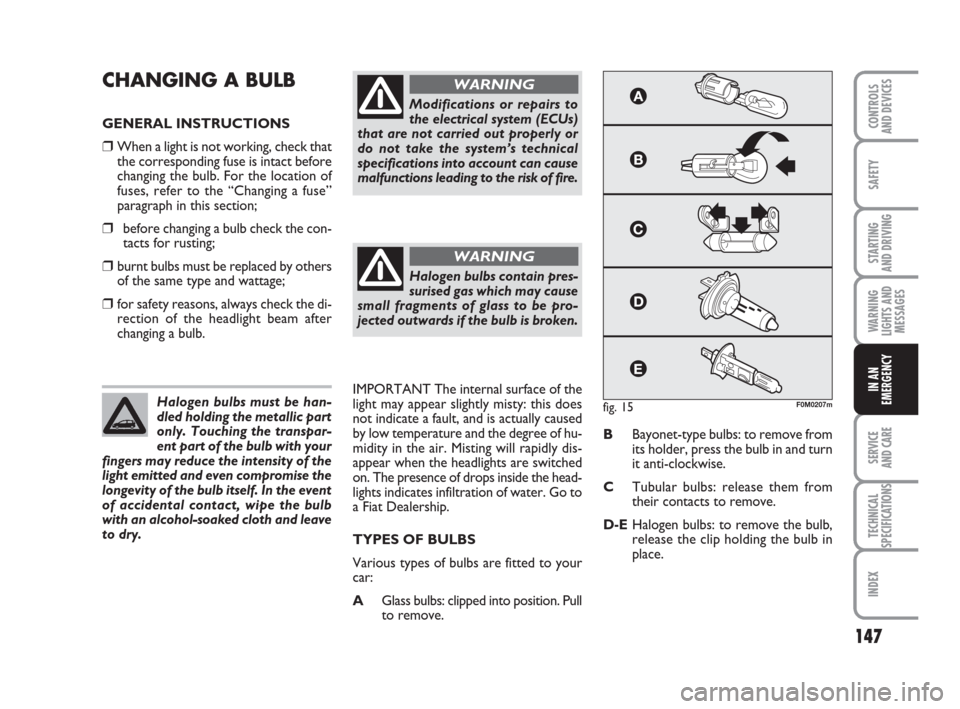
147
SAFETY
STARTING
AND DRIVING
WARNING
LIGHTS AND
MESSAGES
SERVICE
AND CARE
TECHNICAL
SPECIFICATIONS
INDEX
CONTROLS
AND DEVICES
IN AN
EMERGENCY
CHANGING A BULB
GENERAL INSTRUCTIONS
❒When a light is not working, check that
the corresponding fuse is intact before
changing the bulb. For the location of
fuses, refer to the “Changing a fuse”
paragraph in this section;
❒before changing a bulb check the con-
tacts for rusting;
❒burnt bulbs must be replaced by others
of the same type and wattage;
❒for safety reasons, always check the di-
rection of the headlight beam after
changing a bulb.
IMPORTANT The internal surface of the
light may appear slightly misty: this does
not indicate a fault, and is actually caused
by low temperature and the degree of hu-
midity in the air. Misting will rapidly dis-
appear when the headlights are switched
on. The presence of drops inside the head-
lights indicates infiltration of water. Go to
a Fiat Dealership.
TYPES OF BULBS
Various types of bulbs are fitted to your
car:
AGlass bulbs: clipped into position. Pull
to remove.BBayonet-type bulbs: to remove from
its holder, press the bulb in and turn
it anti-clockwise.
CTubular bulbs: release them from
their contacts to remove.
D-EHalogen bulbs: to remove the bulb,
release the clip holding the bulb in
place. Halogen bulbs must be han-
dled holding the metallic part
only. Touching the transpar-
ent part of the bulb with your
fingers may reduce the intensity of the
light emitted and even compromise the
longevity of the bulb itself. In the event
of accidental contact, wipe the bulb
with an alcohol-soaked cloth and leave
to dry.
Modifications or repairs to
the electrical system (ECUs)
that are not carried out properly or
do not take the system’s technical
specifications into account can cause
malfunctions leading to the risk of fire.
WARNING
Halogen bulbs contain pres-
surised gas which may cause
small fragments of glass to be pro-
jected outwards if the bulb is broken.
WARNING
fig. 15F0M0207m
135-166 ACTUAL 1ed EN 26-07-2010 16:00 Pagina 147
Page 151 of 216
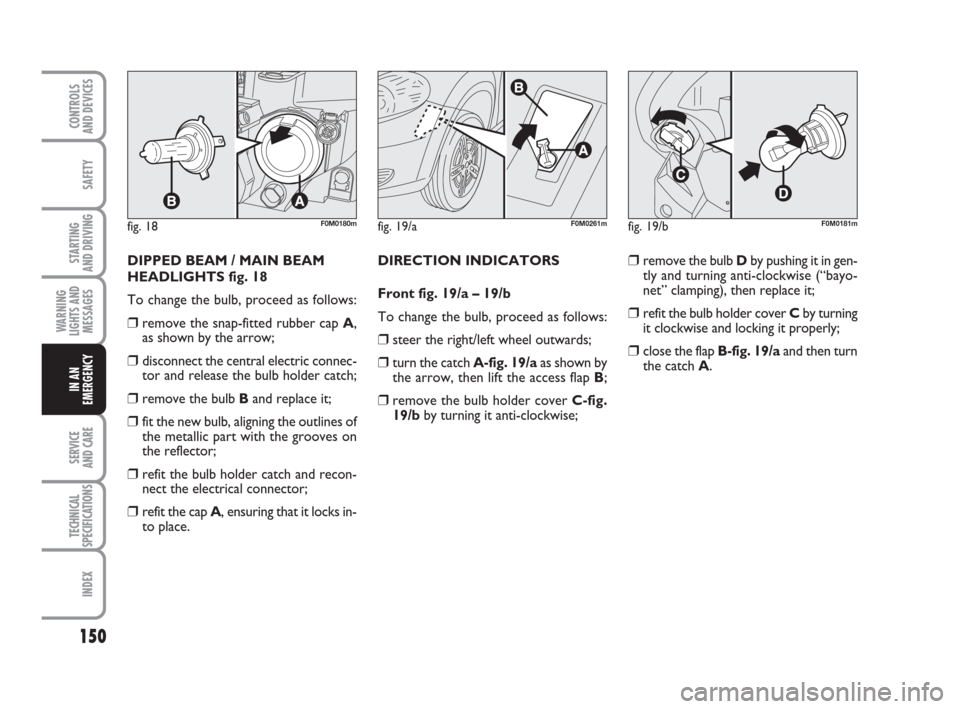
150
SAFETY
STARTING
AND DRIVING
WARNING
LIGHTS AND
MESSAGES
SERVICE
AND CARE
TECHNICAL
SPECIFICATIONS
INDEX
CONTROLS
AND DEVICES
IN AN
EMERGENCY
DIPPED BEAM / MAIN BEAM
HEADLIGHTS fig. 18
To change the bulb, proceed as follows:
❒remove the snap-fitted rubber cap A,
as shown by the arrow;
❒disconnect the central electric connec-
tor and release the bulb holder catch;
❒remove the bulb Band replace it;
❒fit the new bulb, aligning the outlines of
the metallic part with the grooves on
the reflector;
❒refit the bulb holder catch and recon-
nect the electrical connector;
❒refit the cap A, ensuring that it locks in-
to place.DIRECTION INDICATORS
Front fig. 19/a – 19/b
To change the bulb, proceed as follows:
❒steer the right/left wheel outwards;
❒turn the catch A-fig. 19/aas shown by
the arrow, then lift the access flap B;
❒remove the bulb holder cover C-fig.
19/bby turning it anti-clockwise;
❒remove the bulb Dby pushing it in gen-
tly and turning anti-clockwise (“bayo-
net” clamping), then replace it;
❒refit the bulb holder cover Cby turning
it clockwise and locking it properly;
❒close the flap B-fig. 19/aand then turn
the catch A.
fig. 18F0M0180mfig. 19/bF0M0181mfig. 19/aF0M0261m
135-166 ACTUAL 1ed EN 26-07-2010 16:00 Pagina 150
Page 170 of 216
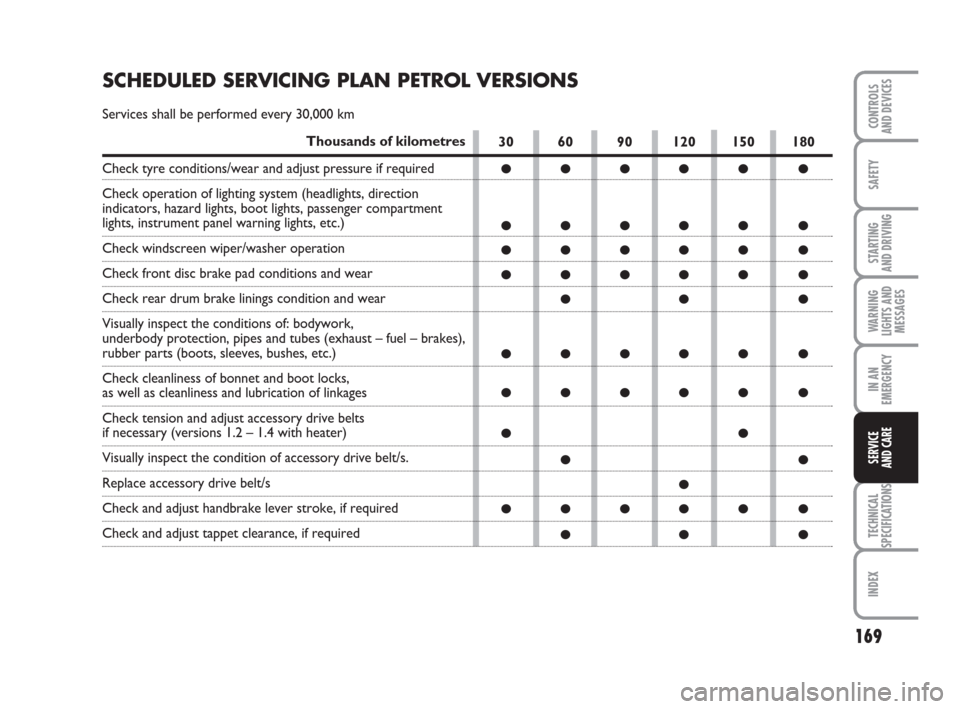
169
SAFETY
STARTING
AND DRIVING
WARNING
LIGHTS AND
MESSAGES
IN AN
EMERGENCY
TECHNICAL
SPECIFICATIONS
INDEX
CONTROLS
AND DEVICES
SERVICE
AND CARE
30 60 90 120 150 180
●●●●● ●
●●●●● ●
●●●●● ●
●●●●● ●
●● ●
●●●●● ●
●●●●● ●
●●
●●
●
●●●●● ●
●● ●
SCHEDULED SERVICING PLAN PETROL VERSIONS
Services shall be performed every 30,000 km
Thousands of kilometres
Check tyre conditions/wear and adjust pressure if required
Check operation of lighting system (headlights, direction
indicators, hazard lights, boot lights, passenger compartment
lights, instrument panel warning lights, etc.)
Check windscreen wiper/washer operation
Check front disc brake pad conditions and wear
Check rear drum brake linings condition and wear
Visually inspect the conditions of: bodywork,
underbody protection, pipes and tubes (exhaust – fuel – brakes),
rubber parts (boots, sleeves, bushes, etc.)
Check cleanliness of bonnet and boot locks,
as well as cleanliness and lubrication of linkages
Check tension and adjust accessory drive belts
if necessary (versions 1.2 – 1.4 with heater)
Visually inspect the condition of accessory drive belt/s.
Replace accessory drive belt/s
Check and adjust handbrake lever stroke, if required
Check and adjust tappet clearance, if required
167-186 ACTUAL 1ed EN 27-07-2010 10:30 Pagina 169
Page 174 of 216

173
SAFETY
STARTING
AND DRIVING
WARNING
LIGHTS AND
MESSAGES
IN AN
EMERGENCY
TECHNICAL
SPECIFICATIONS
INDEX
CONTROLS
AND DEVICES
SERVICE
AND CARE
DEMANDING USE
OF THE CAR
Should the car be used predominantly in
one of the following particularly demand-
ing conditions:
❒trailer or caravan towing;
❒dusty roads;
❒short (less than 7-8 km) and repeated
journeys in sub-zero temperatures;
❒ frequently idling engine or long-dis-
tance, low-speed driving (e.g. door-to-
door deliveries) or lengthy inactivity;
❒ driving in towns and cities;
you should perform the following inspec-
tions more frequently than shown on the
Scheduled Servicing Plan:
❒ check front disc brake pad conditions
and wear;
❒check cleanliness of bonnet and boot
locks, and cleanliness and lubrication of
linkages;
❒ visually inspect the conditions of: en-
gine, gearbox, transmission, pipes and
tubes (exhaust – fuel – brakes), rubber
parts (boots, sleeves, bushes, etc.);
❒check battery charge and liquid level
(electrolyte);
❒visually inspect the condition of the ac-
cessory drive belts;
❒check pollen filter and replace, if re-
quired;
❒check air filter and replace, if required.
REGULAR CHECKS
Every 1,000 km or before long journeys,
check and, if necessary, top up:
❒engine coolant fluid level;
❒brake fluid level;
❒windscreen washer level;
❒tyre pressure and conditions.
❒operation of lights (headlights, direction
indicators, hazard lights, etc.);
❒operation of the windscreen wiper/
washer system, position and wear of
the windscreen and rear window wiper
blades;
Every 3,000 km, check and top up, if re-
quired, the engine oil level.
You are recommended to use PETRONAS
LUBRICANTS products, which have been
designed and produced specifically for
Fiat cars (see table “Capacities” in the
“Technical specifications” section).
167-186 ACTUAL 1ed EN 27-07-2010 10:30 Pagina 173
Page 186 of 216

185
SAFETY
STARTING
AND DRIVING
WARNING
LIGHTS AND
MESSAGES
IN AN
EMERGENCY
TECHNICAL
SPECIFICATIONS
INDEX
CONTROLS
AND DEVICES
SERVICE
AND CARE
Standard upkeep of the paintwork consists
of washing the vehicle: the frequency de-
pends on the conditions and environment
where the vehicle is used. For example, it
is advisable to wash the car more often in
areas with high atmospheric pollution or
on gritted roads.
To wash the car properly, proceed as fol-
lows:
❒if taking your car through an automat-
ic car wash, remove the aerial from the
roof;
❒wash the body using a low-pressure jet
of water;
❒use a sponge to wipe a slightly soapy so-
lution over the bodywork, frequently
rinsing the sponge;
❒rinse with plenty of water and dry with
a jet of air or a chamois leather.
Take particular care when drying the less
visible parts, such as the door, bonnet and
headlight frames, where water can stagnate
more easily. It is a good idea to leave the
car in the open for a while after washing
it to give time for the water to evaporate.Do not wash the car after it has been left
in the sun or with the bonnet hot: this may
alter the shine of the paintwork.
Exterior plastic parts must be cleaned in
the same way as the rest of the car.
Where possible, do not park under trees;
the resinous substances that fall off many
species give the paint a dull appearance
and increase the possibility of triggering
rust processes.
IMPORTANT Bird droppings should be
washed off immediately and thoroughly
as the acid they contain is particularly
aggressive.Detergents pollute water. The
vehicle should be washed only
in areas equipped for collect-
ing and purifying the liquids
used in the washing process.
Windows
Use specific detergents to clean the win-
dows.
Also use clean cloths to avoid scratching
the glass or altering the transparency.
IMPORTANT Wipe the rear window
gently with a cloth in the direction of the
filaments to avoid damaging the heating
device.
Engine compartment
Wash the engine compartment thor-
oughly at the end of every winter. Be care-
ful not to direct the jet of water onto elec-
tronic control units. Adequately protect
the upper air vents to prevent damage to
the windscreen wiper motor. Have this
operation performed at a specialised
workshop.
IMPORTANT Washing should take place
with a cold engine and with the key at
STOP. After the wash, make sure that
the various protective devices (e.g. rubber
caps and guards) have not been removed
or damaged.
Front headlights
IMPORTANT Never use aromatic sub-
stances (e.g. petrol) or ketenes (e.g. ace-
tone) for cleaning the plastic lenses of the
front headlights.
167-186 ACTUAL 1ed EN 27-07-2010 10:30 Pagina 185
Page 206 of 216

205
SAFETY
STARTING
AND DRIVING
WARNING
LIGHTS AND
MESSAGES
IN AN
EMERGENCY
SERVICE
AND CARE
TECHNICAL
SPECIFICATIONS
INDEX
CONTROLS
AND DEVICESBonnet ............................................ 70
Boot ................................................. 67
– opening the boot
in an emergency ...................... 67
– opening and closing
the boot .................................... 67
– extension .................................. 68
Boot extension .............................. 68
Brake Assist (emergency
braking assistance) ..................... 75
Brake fluid level ............................. 178
Brakes
– properties ................................. 193
– fluid level ................................... 178
Bulb (replacement)
– general information ................ 147
– bulb types ................................. 148
Car inactivity ................................ 122
Card/CD holder ........................... 58
Carrying children safely ............... 99
Ceiling lights ................................... 51
Changing a wheel .......................... 137
Chassis (marking) ......................... 188Checking levels ............................. 174
Child lock ....................................... 64
Child seats
(suitability for use) ............102-104
Cigarette lighter ............................ 58
Clutch .............................................. 192
CO
2emissions .............................. 204
Code Card ..................................... 8
Consumptions
– fuel ............................................. 204
– engine oil .................................. 176
Control buttons ............................ 53
Cup/can holder ............................. 58
Cup/can holders ............................ 58
Dashboard .................................... 5
Dashboard and controls ............. 4
Dead lock (device) ....................... 63
Digital display ................................. 16
Dimensions .................................... 198
Dipped beam headlights
– control ...................................... 47
– bulb replacement .................... 150
Ability to install
navigation system ....................... 88
ABS .................................................. 74
ABS system .................................... 74
Accessories purchased
by the owner ............................... 88
Air filter .......................................... 179
Alarm .............................................. 10
Arm rest ......................................... 57
Ashtray ........................................... 59
ASR .................................................. 77
– activation/deactivation ............ 77
ASR system .................................... 77
Battery
– jump starting ............................ 136
– checking the charge ............... 179
– recharging ................................. 163
– replacement ............................. 179
Bodywork
– maintenance ............................. 184
– version codes .......................... 190
I I
N N
D D
E E
X X
205-214 ACTUAL 1ed EN 26-07-2010 16:15 Pagina 205
Page 207 of 216
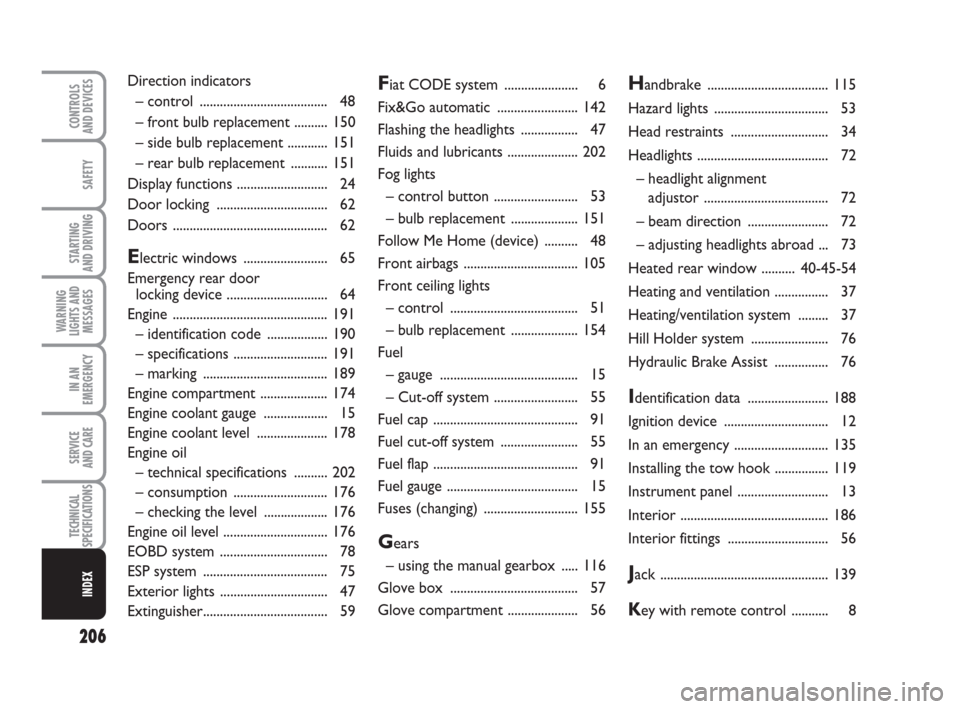
206
SAFETY
STARTING
AND DRIVING
WARNING
LIGHTS AND
MESSAGES
IN AN
EMERGENCY
SERVICE
AND CARE
TECHNICAL
SPECIFICATIONS
INDEX
CONTROLS
AND DEVICES
Fiat CODE system ...................... 6
Fix&Go automatic ........................ 142
Flashing the headlights ................. 47
Fluids and lubricants ..................... 202
Fog lights
– control button ......................... 53
– bulb replacement .................... 151
Follow Me Home (device) .......... 48
Front airbags .................................. 105
Front ceiling lights
– control ...................................... 51
– bulb replacement .................... 154
Fuel
– gauge ......................................... 15
– Cut-off system ......................... 55
Fuel cap ........................................... 91
Fuel cut-off system ....................... 55
Fuel flap ........................................... 91
Fuel gauge ....................................... 15
Fuses (changing) ............................ 155
Gears
– using the manual gearbox ..... 116
Glove box ...................................... 57
Glove compartment ..................... 56
Handbrake .................................... 115
Hazard lights .................................. 53
Head restraints ............................. 34
Headlights ....................................... 72
– headlight alignment
adjustor ..................................... 72
– beam direction ........................ 72
– adjusting headlights abroad ... 73
Heated rear window ..........40-45-54
Heating and ventilation ................ 37
Heating/ventilation system ......... 37
Hill Holder system ....................... 76
Hydraulic Brake Assist ................ 76
Identification data ........................ 188
Ignition device ............................... 12
In an emergency ............................ 135
Installing the tow hook ................ 119
Instrument panel ........................... 13
Interior ............................................ 186
Interior fittings .............................. 56
Jack .................................................. 139
Key with remote control ........... 8 Direction indicators
– control ...................................... 48
– front bulb replacement .......... 150
– side bulb replacement ............ 151
– rear bulb replacement ........... 151
Display functions ........................... 24
Door locking ................................. 62
Doors .............................................. 62
Electric windows ......................... 65
Emergency rear door
locking device .............................. 64
Engine .............................................. 191
– identification code .................. 190
– specifications ............................ 191
– marking ..................................... 189
Engine compartment .................... 174
Engine coolant gauge ................... 15
Engine coolant level ..................... 178
Engine oil
– technical specifications .......... 202
– consumption ............................ 176
– checking the level ................... 176
Engine oil level ............................... 176
EOBD system ................................ 78
ESP system ..................................... 75
Exterior lights ................................ 47
Extinguisher..................................... 59
205-214 ACTUAL 1ed EN 26-07-2010 16:15 Pagina 206